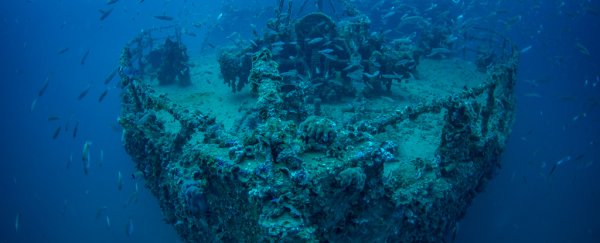There are estimated to be around three million shipwrecks sitting on sea beds around the world, many of them made from wood – and these submerged wooden islands are proving a vibrant breeding ground for deep sea microbes, a new study reveals.
Scientists say these human-made structures are having an important impact on the delicate ecosystems down at the bottom of the oceans, to an extent that hasn't really been appreciated before.
Deep sea microbes living on submerged shipwrecks are positioned at the bottom of the underwater food chain, so changes to them could have a knock-on effect on other marine life – and, ultimately, everything living on the land as well.
"Microbial communities are important to be aware of and understand because they provide early and clear evidence of how human activities change life in the ocean," says molecular microbial ecologist Leila Hamdan from the University of Southern Mississippi.
Hamdan and fellow researchers picked two 19th century shipwreck sites in the Gulf Mexico for their study. They placed pine and oak blocks around the sites, from right next to the shipwrecks to up to 200 meters (656 feet) away, and left the wood there for four months.
The wooden blocks were then recovered and measured for bacteria, archaea, and fungi. Microbial diversity varied depending on proximity to the wreck sites, peaking around 125 meters (410 feet) away. The type of wood made a difference as well, with oak more favorable to microbial biodiversity than pine.
Natural hard habitats – trees that have fallen into rivers and the oceans – are already well known for influencing the biodiversity of the water they tumble into. What this study shows is that shipwrecks abandoned by humans affect microbial life under the sea too.
"These biofilms are ultimately what enable hard habitats to transform into islands of biodiversity," says Hamdan.
Overall, across the two sites, the presence of the shipwrecks increased microbial richness in the surrounding water, and altered the composition and dispersal patterns of the biofilms holding microbes, the researchers found.
As expected, additional factors influencing microbial life were water depth and the closeness to other nutrient sources, such as the Mississippi River delta.
While further research is needed to investigate the phenomenon at a broader range of sites, these initial findings are enough to show that shipwrecks are an important consideration in underwater biodiversity.
The team behind this latest study suggests that other human-made structures, such as oil rigs, could be having a similar impact on deep sea microbiomes, and again further research is justified in attempting to find out specifics.
"While we are aware human impacts on the seabed are increasing through the multiple economic uses, scientific discovery is not keeping pace with how this shapes the biology and chemistry of natural under sea landscapes," says Hamdan.
"We hope this work will begin a dialogue that leads to research on how built habitats are already changing the deep sea."
The research has been published in Frontiers in Marine Science.
